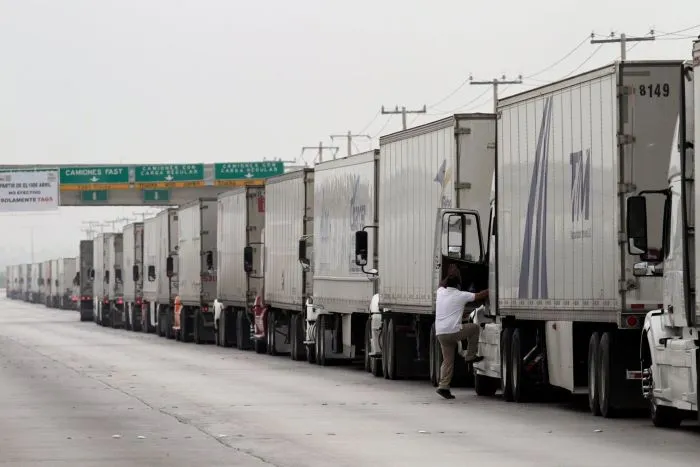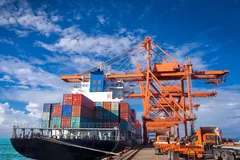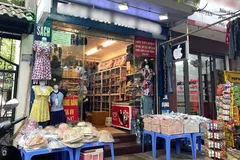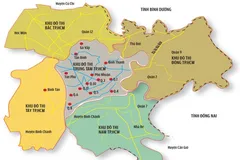
President Trump said Friday that “there is a good chance” the U.S. and Mexico would reach a deal to avert the new 5% tariff and indicated that it might include some trade elements, beyond simply holding off on the threatened tariffs against Mexican imports.
Mexico “will begin purchasing Farm & Agricultural products at very high levels, starting immediately” if a deal is struck, Mr. Trump tweeted from Air Force One as he returned to the U.S. from Europe.
Failure to reach a deal would force U.S. Customs and Border Protection, the federal agency that collects tariffs from importers and manages the flow of goods, to implement a new system quickly at a border where some companies haven’t paid tariffs since the North American Free Trade Agreement went into effect 25 years ago.
“These things don’t turn on a dime,” said John Murphy, senior vice president for international policy at the U.S. Chamber of Commerce. “It’s a tall order to ask CBP to begin levying duties on imports from a major trading partner for the first time in years—and get it all done in 10 days.”
In Washington, negotiators for the U.S. and Mexico met for a third day on Friday to build on the momentum in their border-security talks ahead of Monday’s deadline.
The U.S. has called on Mexico to block more migrants at its southern border with Guatemala, and to step up efforts against organized smuggling in order to slow the number of people crossing into the U.S. after fleeing violence in Central America.
The U.S. has also pressed Mexico to designate itself a “safe third country,” which would mean people entering Mexico from Guatemala, Honduras and El Salvador wouldn’t be eligible to claim asylum in the U.S. Absent a deal, President Trump has threatened to impose escalating tariffs on Mexico.
Mexican President Andrés Manuel López Obrador said Friday morning he remains optimistic an agreement can be reached before Monday. He declined to say whether his government is willing to accept becoming a safe third country, saying that was up to Foreign Minister Marcelo Ebrard and his negotiating team.
Currently, most Mexican goods enter the U.S. tax-free under the terms of Nafta, though the U.S. levies small duties on some products that don’t meet Nafta regulations.
The tariffs, which would be paid by U.S. importers of Mexican goods, would begin at 5% on Monday, double to 10% on July 1 and continue escalating to 25% by October. It would be the single largest imposition of tariffs by the Trump administration, exceeding any of those against China, as well as the administration’s global tariffs on steel and aluminum.
Some $40 million an hour in goods crosses into the U.S. from Mexico. The U.S. imported $346.5 billion in goods from Mexico in 2018, according to the U.S. Trade Representative.
In April, amid escalating trade tensions with China, the U.S. for the first time recorded more monthly trade volume with Mexico than with any other country.
In May, the overland border crossing at Laredo, Texas, surpassed the Port of Los Angeles and Long Beach, Calif., as America’s busiest border crossing, with more than $20 billion in two-way trade in the month, according to U.S. Census data.
More than 12,000 trucks cross the overland border crossing at Laredo every day, carrying a total of $234 billion in imports and exports in 2018.
Adrian Gonzalez, head of U.S. trade compliance of Nidec Motor Corp., which is a Japanese manufacturer of motors that go into General Motors cars and Whirlpool appliances and has a large plant in Reynosa, a Mexican city across the border from McAllen, Texas, said the company has been expanding in Mexico in recent years in part to avoid tariffs resulting from the Trump administration’s trade fight with China.
Tariffs on Chinese imports have cost the company tens of millions of dollars, he said, most of which has been passed on to customers in the form of price increases. This spring, the company saw long delays at the border after CBP shifted hundreds of customs agents to humanitarian duty, a scenario Mr. Gonzalez fears might be repeated with the new tariffs.
“Every time there’s a piece of positive news, like the ratification of USMCA, we get hit with a bucket of cold water, like with these tariffs,” Mr. Gonzalez said, referring to the U.S. Mexico Canada Agreement, a trade deal approved by the leaders of all three countries last year to modernize Nafta. “It feels like everything keeps piling up.”
New tariffs must be first published in the Federal Register, the official log of all new agency rules, then programmed into CBP’s computer system and disseminated to the companies that handle shippers’ paperwork, software and logistics, before the levies can be collected.
The U.S. plans to submit legal notification of the tariffs on Friday, a spokesman for Vice President Mike Pence told reporters on Friday.
“If this comes out in the Federal Register Friday night, we’re going to have major issues. No one will be ready,” said Adam Hill, a customs broker with Scarborough International in Kansas City, Mo., who specializes in cross-border trade with Mexico-based companies. “That will mean unbelievably long lines at the ports of entry and a slowdown of trade overall.”
In past years, each truck had to wait hours in queues before crossing while paperwork was inspected. But importers, logistics firms and customs brokers have spent decades streamlining cross-border trade to suit the fast pace of an increasingly globalized economy.
Since the 9/11 terrorist attacks, the U.S. government has modernized the commercial-traffic processing system, implementing fast lanes at border crossings for pre-approved shippers and digitizing customs records. CBP says that today some 10,000 companies are enrolled in its pre-approved shipping program, and academic studies have found that wait times for trucks have been reduced to less than 40 minutes on average.
Most large shippers, including companies that manufacture parts for the automotive, appliance, medical-device and aerospace industries, use CBP’s digital customs system, known as Automated Commercial Environment, or ACE, to document the contents of a cargo shipment ahead of time, which speeds the pace of trade at the border.
But a generation of smaller companies, mainly smaller suppliers that aren’t as accustomed to using ACE, would have trouble adapting to major changes like new tariffs, said Gary Nichols, a trucking industry executive who specializes in U.S.-Mexico shipping and has worked for three decades for companies such as USATruck Inc. and Con-Way Inc.
“If there are tariffs imposed and the terms of their agreement put the burden of doing all the paperwork and getting pre-approvals on the Mexican side, then that will cause major delays at the border,” he said.
A number of business groups have raised questions about the ability of CBP to collect the tariffs from a generation of U.S. importers that haven’t paid tariffs at all since Nafta took effect 25 years ago.
Importers typically have 10 days after a cargo enters the U.S. to file the paperwork necessary to pay tariffs electronically.
The Pacific Coast Council of Customs Brokers and Freight Forwarders wrote a letter to acting Homeland Security Secretary Kevin McAleenan, who oversees CBP, and to U.S. Trade Representative Robert Lighthizer on Thursday, highlighting concerns about the lack of logistical preparedness to impose the tariffs.
The letter said that CBP has notified importers applying for an account for the first time that “due to increased volume,” the process can take 15 business days to set up the account, meaning that many new businesses cannot possibly comply in time.
In many cases, customs brokers can pay the tariffs on behalf of clients who are importers. But the Pacific Coast Council said that many don’t have the capacity to front tariffs of this scale—a 5% tariff on the roughly $350 billion of Mexican imports would amount to around $18 billion a year of tariff collections from imports that currently pay nearly nothing.
They provided an example, saying that a relatively small importer might bring in $1 million of goods a month, resulting in a $50,000 tariff bill in June and $100,000 in July. A customs broker with 100 such importer clients would need to come up with $5 million just to pay the new June tariffs, far beyond the scale, they said, of most brokers in the business.
CBP didn’t immediately respond to a request for comment. The U.S. Trade Representative declined to comment, saying the proposed tariffs were “not a USTR process.”
Daniel Ujczo, a trade lawyer who represents dozens of auto-parts manufacturers and other importers and exporters in the U.S. and Mexico, said tariffs would result in “huge slowdowns” and higher costs to business.
“After a difficult spring, we were just starting to see the light at the end of the tunnel,” he said. “The most significant impacts will be on small and medium-sized suppliers down the supply chain, and those are the very companies that employ a key part of the president’s base. This is certainly shooting yourself in the foot.”




















